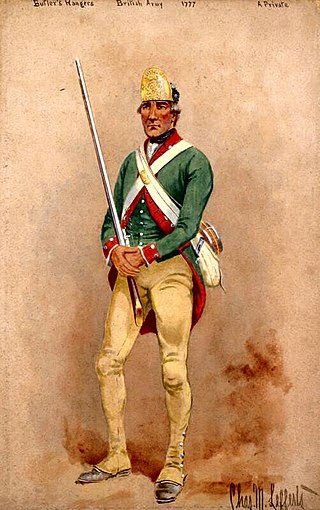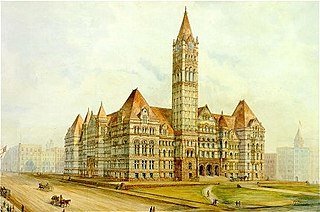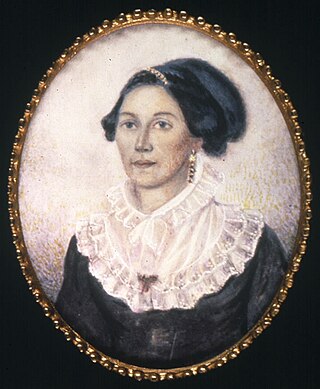
Sir William Johnson, 1st Baronet, was a British Army officer and colonial administrator from Ireland known for his military and governance work in British colonial America.

Thayendanegea or Joseph Brant was a Mohawk military and political leader, based in present-day New York and, later, Brantford, in what is today Ontario, who was closely associated with Great Britain during and after the American Revolution. Perhaps the best known Native American of his generation, he met many of the most significant American and British people of the age, including both United States President George Washington and King George III of Great Britain.

John Butler was an American-born military officer, landowner, colonial official in the British Indian Department, and merchant. During the American Revolutionary War, he was a prominent Loyalist who led the provincial regiment known as Butler's Rangers. Born in Connecticut, he moved to New York with his family, where he learned several Iroquoian languages and worked as an interpreter in the fur trade. He was well-prepared to work with the Mohawk and other Iroquois nations who became allies of the British during the rebellion.

Butler's Rangers (1777–1784) was a Loyalist provincial military unit of the American Revolutionary War, raised by American loyalist John Butler. Most members of the regiment were Loyalists from upstate New York and northeastern Pennsylvania. Their winter quarters were constructed on the west bank of the Niagara River, in what is now Niagara-on-the-Lake, Ontario. The Rangers fought principally in New York and Pennsylvania, but ranged as far west as Ohio and Michigan, and as far south as Virginia and Kentucky.

Events from the year 1799 in Canada.

Brigadier-General Sir John Johnson, 2nd Baronet was an American-born military officer, magistrate, landowner in the British Indian Department who fought as a Loyalist during the American Revolutionary War. He was the son of Sir William Johnson, 1st Baronet, who was the first British Superintendent of Indian Affairs. He inherited his father's baronetcy and estate in 1774.

Guy Johnson was an Irish military officer and diplomat. He served on the side of the British during the Revolutionary War, having migrated to the Province of New York as a young man and worked with his uncle, Sir William Johnson who served as the British Superintendent of Indian Affairs of the northern colonies.

Molly Brant, also known as Mary Brant, Konwatsi'tsiaienni, and Degonwadonti, was a Mohawk leader in British New York and Upper Canada in the era of the American Revolution. Living in the Province of New York, she was the consort of Sir William Johnson, the British Superintendent of Indian Affairs, with whom she had eight children. Joseph Brant, who became a Mohawk leader and war chief, was her younger brother.
Ralfe Clench was a farmer, judge and political figure in Upper Canada. His first name is also sometimes recorded as Ralph or Rudolf; his last name is sometimes recorded as Clinch.

John Norton (Teyoninhokarawen) was a Mohawk chief, Indian Department interpreter and a school master. He was adopted by the Mohawk at about age 30 at their major reserve in Canada. After deserting the British military in the late 18th century, he became a military leader of Iroquois warriors in the War of 1812 on behalf of Great Britain against the United States. Commissioned as a major, he led warriors from the Six Nations of the Grand River into battle against American invaders at Queenston Heights, Stoney Creek, and Chippawa.
William Johnson Kerr was a political figure in Upper Canada.

John Brant or Ahyonwaeghs was a Mohawk chief and government official in Upper Canada.

The Toronto Purchase was the sale of lands in the Toronto area from the Mississaugas of New Credit to the British crown. An initial, disputed, agreement was made in 1787, in exchange for various items. The agreement was revisited in 1805, intended to clarify the area purchased. The agreement remained in dispute for over 200 years until 2010, when a settlement for the land was made between the Government of Canada and the Mississaugas for the land and other lands in the area.
The 1764 Treaty of Fort Niagara is one of the first treaty agreements made between First Nations and The Crown. It is a notable example of The Crown's recognition of Indigenous sovereignty in the years preceding the American Revolution. However, the agreement was recorded in wampum and no paper document was signed; Canadian law does not recognize the legality of the agreement.

Christian Daniel Claus (1727—1787) was a Deputy Agent in the British Indian Department and a prominent Loyalist during the American Revolution.

Augustus Jones was a North American-born Upper Canadian farmer, land speculator, magistrate, militia captain and surveyor. Jones trained as a surveyor in New York City, and fled as a United Empire Loyalist to Upper Canada. In Upper Canada, he worked as a crown surveyor in the Nassau District, where he quickly rose to the position of Deputy Surveyor General, the highest position in a district of Upper Canada. He occupied that position from 1789 informally, and 1791 formally, until his retirement in 1799. During that time he laid down many of the township boundaries in the Niagara Peninsula and on the north shore of Lake Ontario. He led various teams that cut many of the first sideroads and concession roads into these areas, facilitating their settlement by European and American immigrants. Jones also surveyed the routes for Dundas Street and Yonge Street, and supervised their construction. After his retirement, Jones farmed first in Saltfleet Township, later moving to Brantford and finally an estate outside Paris named Cold Springs, where he died in 1836.

The Indian Department was established in 1755 to oversee relations between the British Empire and the First Nations of North America. The imperial government ceded control of the Indian Department to the Province of Canada in 1860, thus setting the stage for the development of the present-day Department of Crown–Indigenous Relations and Northern Affairs Canada.

William Claus (1765–1826) was a member of the Executive Council of Upper Canada, a colonel of the Canadian militia during the War of 1812, and the head of the Indian Department in Upper Canada from 1799 until his death.
Catharine Brant (c.1759–1837), also known as Ahdohwahgeseon, was a clan mother of the Mohawk nation. She was the third wife of Joseph Brant and an important leader among the Six Nations of the Grand River.

Elizabeth Brant, commonly known as Elizabeth Kerr after her marriage to William Johnson Kerr, was a Clan Mother of the Six Nations of the Grand River. She was the daughter of Catharine Brant and Joseph Brant. In the matrilineal society of the Haudenosaunee, Elizabeth Brant inherited her status as a Yakoyaner from her mother.

















